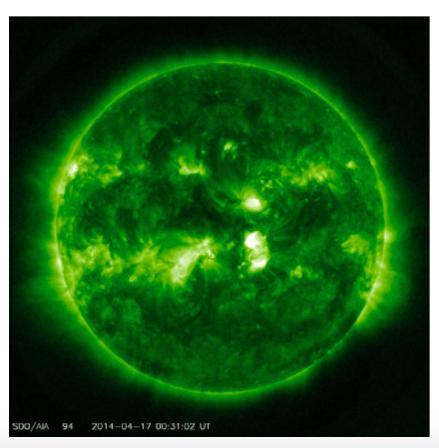A model will help to understand the solar dynamics

This is an image in the solar corona at 171 A. Credit: Solar Dynamic Observatory (SDO)
Plasma β is an important quantity to investigate the interchanging roles of plasma and magnetic pressure in the solar atmosphere. It relates to both the solar magnetic field and driving solar phenomena such as solar wind, coronal mass ejections, and flares; these phenomena affect the Space Weather directly.
Dr. Jenny Rodriguez, a scientist from the Space Center of Skolkovo Institute of Science and Technology (Russia), her colleagues from Leibniz Institut für Sonnenphysik (Germany) and Instituto Nacional de Pesquisas Espaciais (Brazil) have developed a model to estimate how plasma β changes in the solar atmosphere.
Specifically, they obtain a description of the plasma β in the solar corona during previous solar cycles (~22 years). They found the strongest influence during both solar cycles from faculae and the quiet Sun regions.
The faculae and QS regions drive variations in magnetic and kinetic pressure at coronal heights. It can directly affect space weather and the ability to predict it. These results give an interesting outlook on solar cycle dynamics.
“Plasma β is a very important quantity in the solar atmosphere. The solar atmosphere is a plasma physics laboratory near us; it allows us to know about its dynamics and to understand how many events are happening on the Sun. We believe that our findings will help comprehend the Sun's dynamics and help to forecast the Space Weather,” said Dr. Jenny Rodriguez.
Media Contact
All latest news from the category: Physics and Astronomy
This area deals with the fundamental laws and building blocks of nature and how they interact, the properties and the behavior of matter, and research into space and time and their structures.
innovations-report provides in-depth reports and articles on subjects such as astrophysics, laser technologies, nuclear, quantum, particle and solid-state physics, nanotechnologies, planetary research and findings (Mars, Venus) and developments related to the Hubble Telescope.
Newest articles

Sea slugs inspire highly stretchable biomedical sensor
USC Viterbi School of Engineering researcher Hangbo Zhao presents findings on highly stretchable and customizable microneedles for application in fields including neuroscience, tissue engineering, and wearable bioelectronics. The revolution in…

Twisting and binding matter waves with photons in a cavity
Precisely measuring the energy states of individual atoms has been a historical challenge for physicists due to atomic recoil. When an atom interacts with a photon, the atom “recoils” in…

Nanotubes, nanoparticles, and antibodies detect tiny amounts of fentanyl
New sensor is six orders of magnitude more sensitive than the next best thing. A research team at Pitt led by Alexander Star, a chemistry professor in the Kenneth P. Dietrich…





















